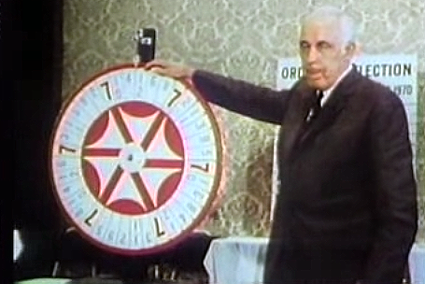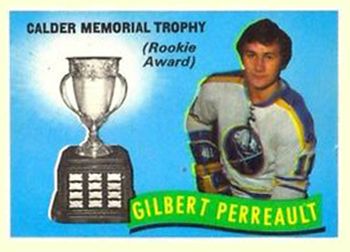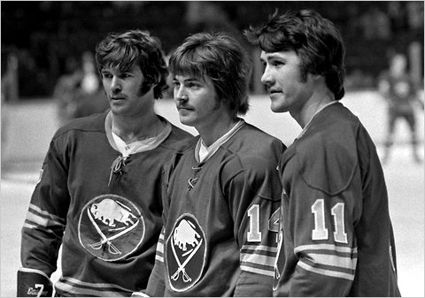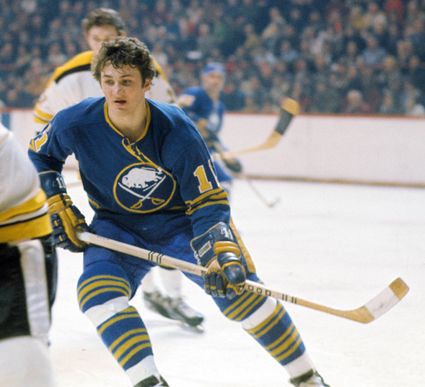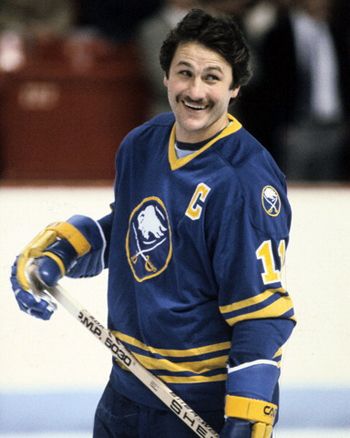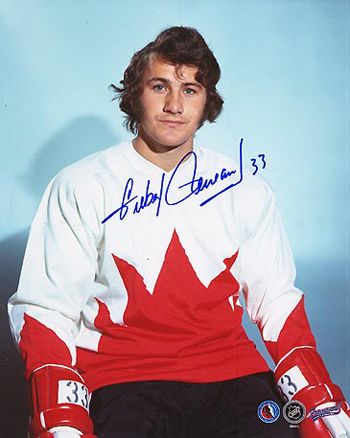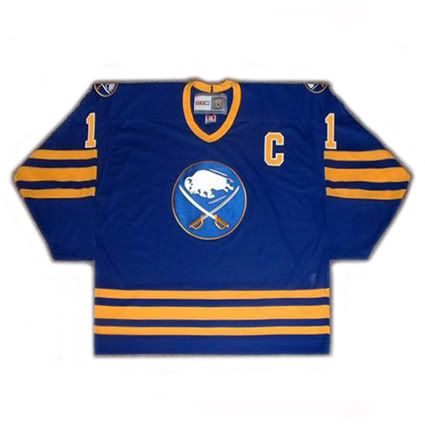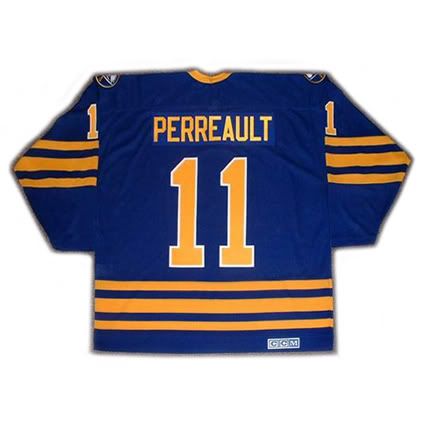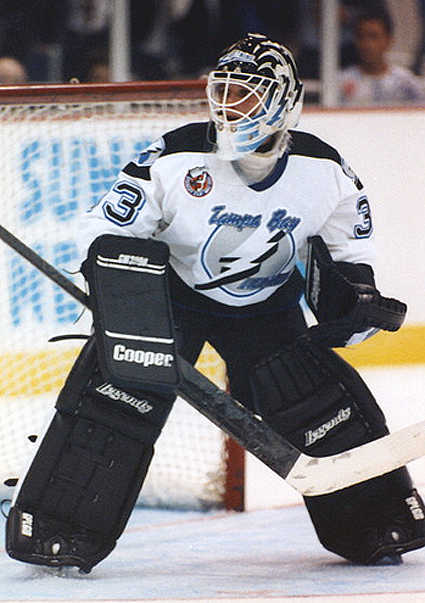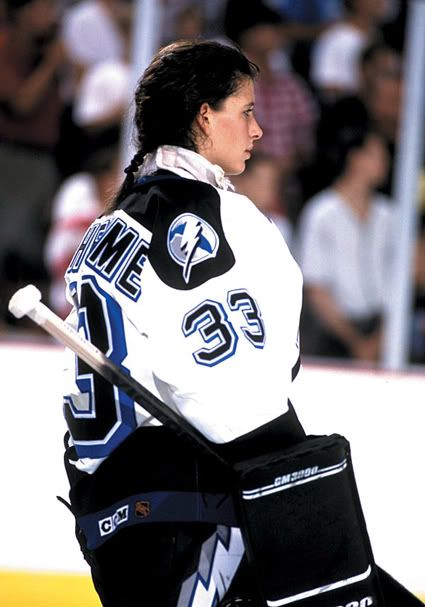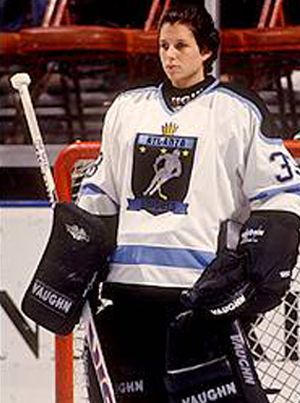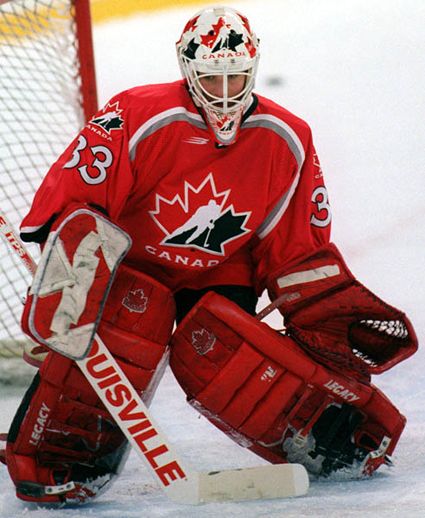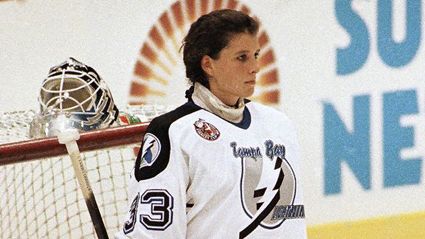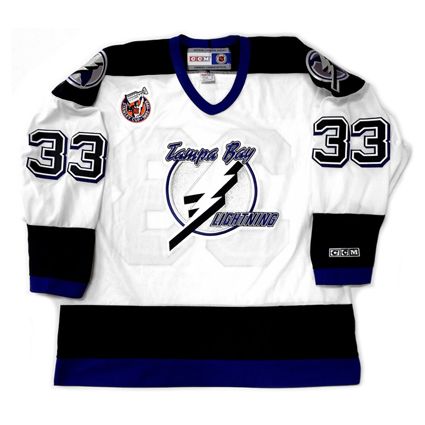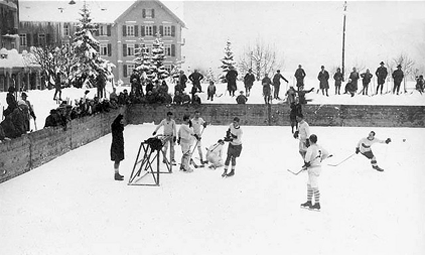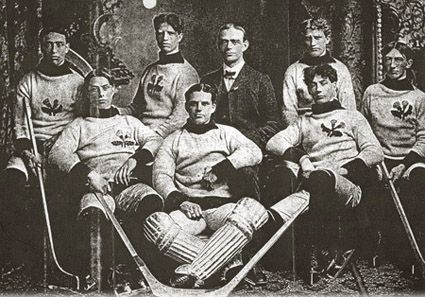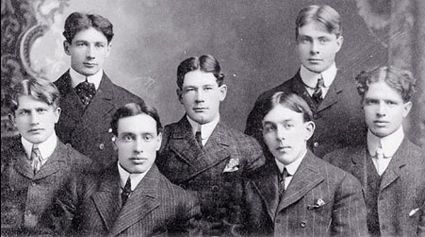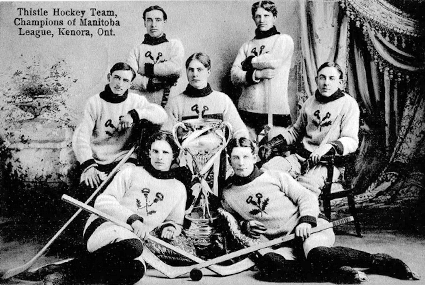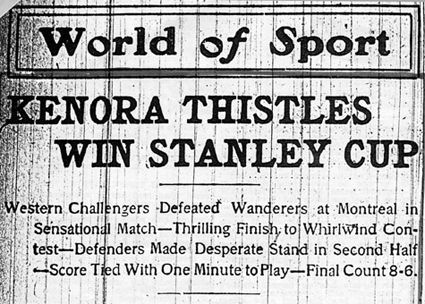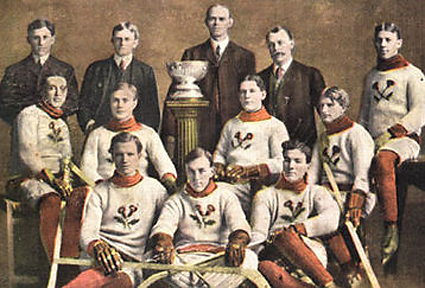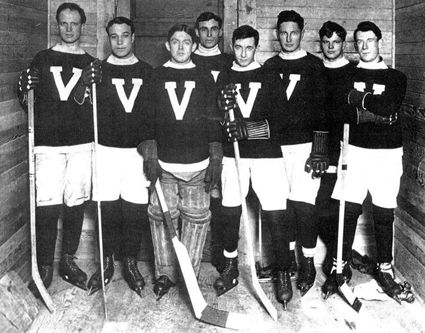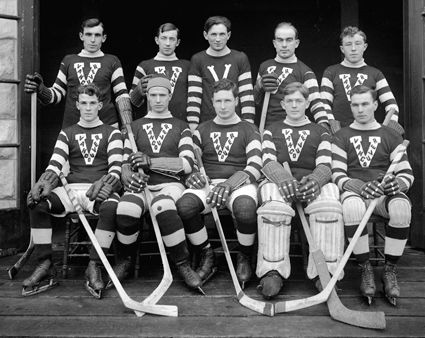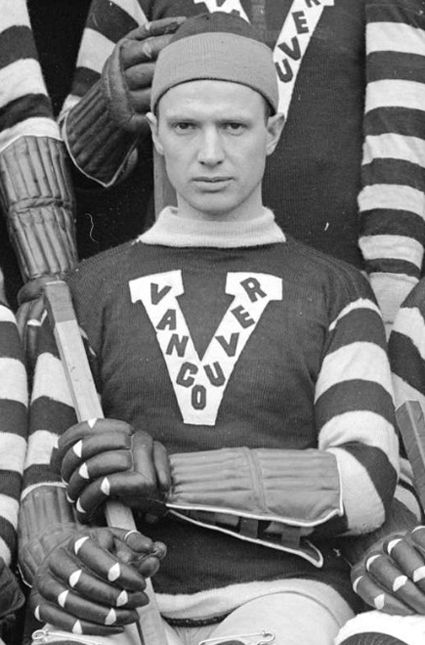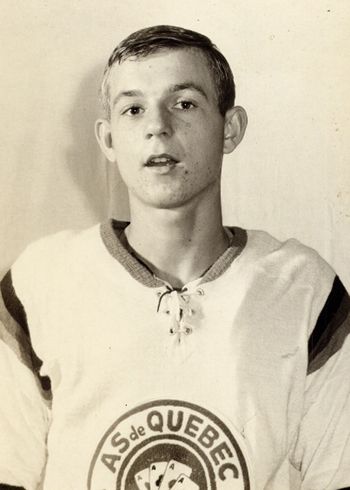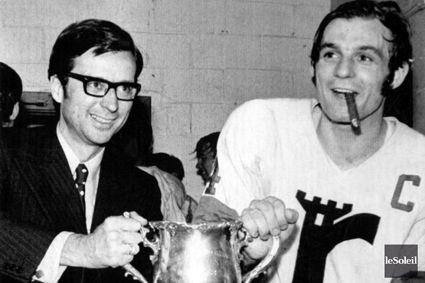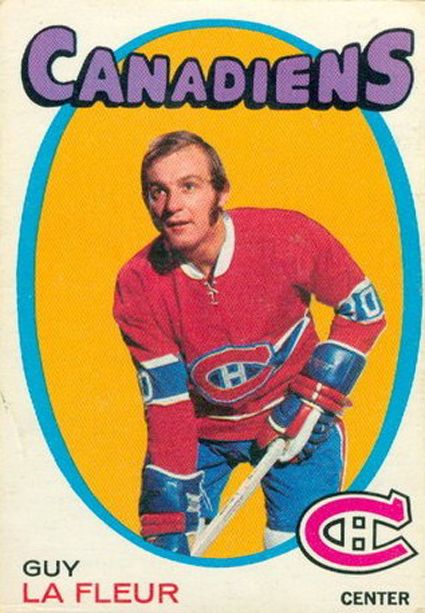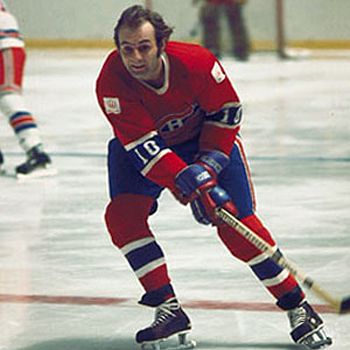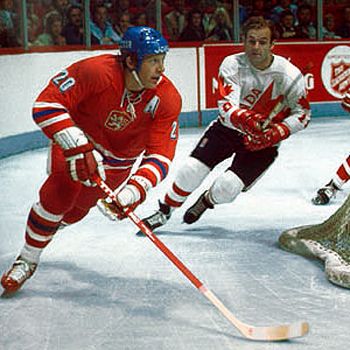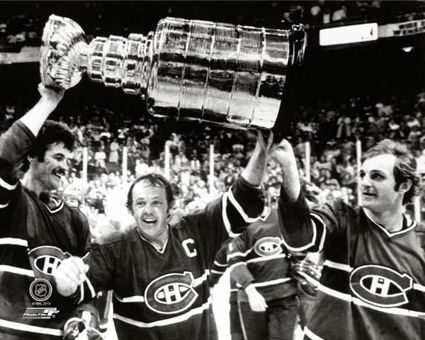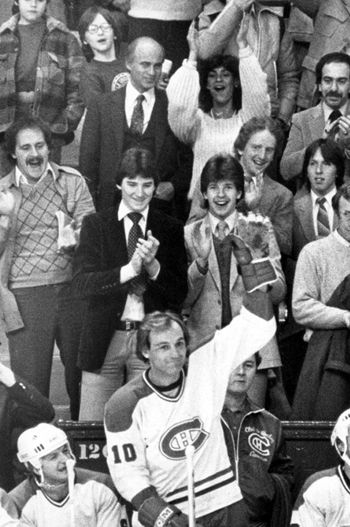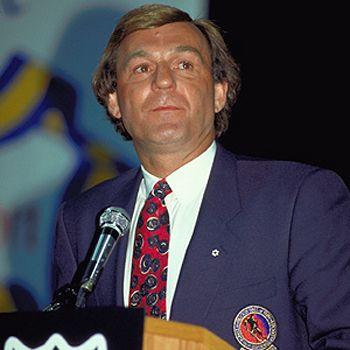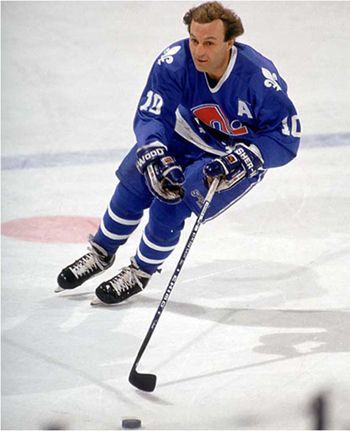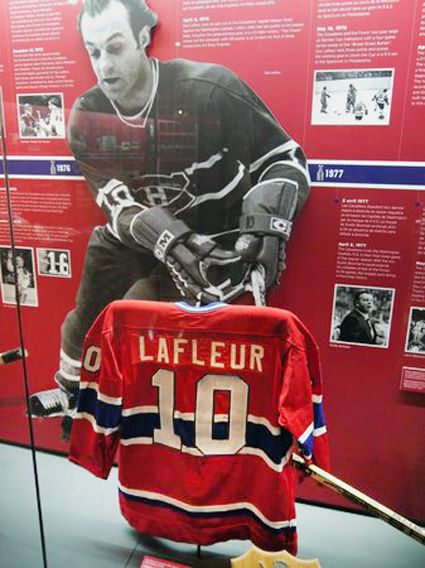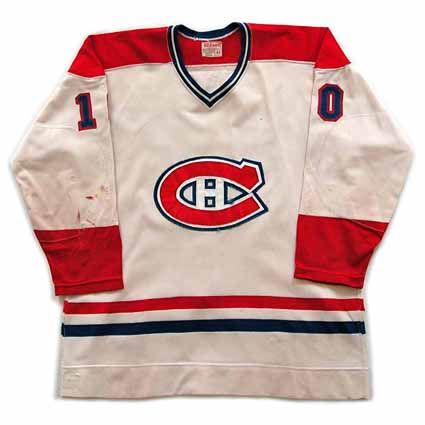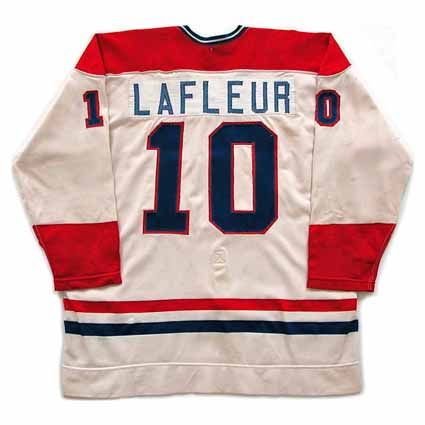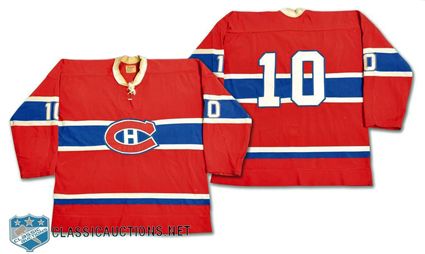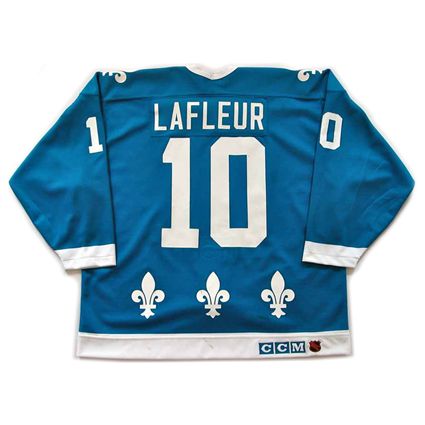Saturday, September 24, 2016
1983-84 Buffalo Sabres Gilbert Perreault Jersey
The first ever draft pick for the fledgling Sabre organization, Gilbert Perreault was drafted first overall in the 1970 NHL Amateur Draft after the Sabres won a spin of a wheel to determine if they or the Vancouver Canucks would pick first. Sabres general manager Punch Imlach chose his favorite number 11, which proved lucky for the Sabres, and is why Perreault was assigned sweater #11.
Clarence Campbell and his lucky number draft wheel,
which awarded Buffalo the first overall draft pick
Perreault scored a goal in the Sabres first ever game on October 10, 1970 and went on to lead the Sabres in scoring with 72 points in 78 games and win the Calder Trophy. He was also the first Sabre to record a power play goal and a hat trick.
Joined by wingers and fellow French-Canadians Rene Robert and Rick Martin during the Sabres second season, they formed "The French Connection" line which would excel for the seven seasons the trio played together, including all three being named to the same NHL All-Star Team on two occasions.
Perreault would lead the Sabres in scoring during 11 of his 17 seasons, including five in a row from 1975-76 to 1979-80. The Sabres would also qualify for the playoffs 11 consecutive seasons, including making it to the Stanley Cup Finals in 1975.
He would be named team captain in 1982, a position he would hold until his retirement in November 1986 and amass 512 goals and 814 assists for 1,326 points in his career in 1191 games - all Sabres franchise records which still stand to this day. He also holds Sabres career records for game winning goals, shots on goal and points in a game with seven.
He would also have the distinction of scoring the game winning goal in overtime of the 1978 NHL All-Star Game played in Buffalo at the Memorial Auditorium, one of nine NHL All-Star games he would appear in during his career.
In addition to his success with the Sabres, Perreault would also play for Team Canada during the 1972 Summit Series and the 1976 Canada Cup.
When he retired, he was the sixth leading scorer in NHL history and was subsequently inducted to the Hockey Hall of Fame on this date in 1990.
Today's featured jersey is a 1983-84 Buffalo Sabres Gilbert Perreault jersey. The Sabres played with essentially the same jerseys from 1970 to 1996 with only slight variations such as eliminating the original tie-neck collars in 1978, the same year they added shoulder logos, and minor changes to the arm and waist stripes in 1983.
This jersey proved so popular with the Sabres fans that it was brought back as a third jersey in 2006-07 and was modernized for a new third jersey again in 2008.
First, a real treat, footage from the first ever Buffalo Sabres game and Perreault's first ever NHL goal against Pittsburgh.
Here is the Legends of Hockey biography of Gilbert Perreault.
Next up is a great compilation of Perreault action highlights.
Finally a musical tribute to "The French Connection" line, featuring Gilbert Perreault.
Labels:
Buffalo Sabres,
Perreault Gilbert
Friday, September 23, 2016
1992-93 Tampa Bay Lightning Manon Rheaume Jersey
On this date in 1992, Manon Rheaume became the first, and to this date only, woman to play in an NHL game.
Tampa Bay General Manager Phil Esposito explains how he first became aware of Rheaume: "I was up in Montreal looking at players and we went to this Junior A game and somebody said they wanted me to see this player. I saw the guy and I didn't think he was very good. I said "I like the little goalie." I didn't know it was a woman, and neither did my scout. I said, "I want to go talk to that goalie. He's got something." So I go down to talk to him and she walked out. I nearly flipped. I said, "Oh my God, she's gorgeous. Who is that girl?" They said, "That's the goalie."
Next, a feature "The Woman Behind the Mask" about her experience with the Lightning.
Tampa Bay General Manager Phil Esposito explains how he first became aware of Rheaume: "I was up in Montreal looking at players and we went to this Junior A game and somebody said they wanted me to see this player. I saw the guy and I didn't think he was very good. I said "I like the little goalie." I didn't know it was a woman, and neither did my scout. I said, "I want to go talk to that goalie. He's got something." So I go down to talk to him and she walked out. I nearly flipped. I said, "Oh my God, she's gorgeous. Who is that girl?" They said, "That's the goalie."
Rheaume was signed by the Tampa Bay Lightning, as an admitted publicity ploy, and played in the first period of the franchise's first home game, an exhibition game against the St. Louis Blues. She allowed two goals on nine shots, scored by Jeff Brown and Brendan Shanahan.
From Esposito's book "Thunder and Lightning", his take on her tryout with the Lightning;
During that training camp, I signed Manon Rheaume to come and play for us. Manon was a goaltender, and she was a beautiful young woman.I found Manon through Jacques Campeau. Jacques was the one who convinced me to sign Manon Rheaume. We went up to a women's tournament and watched her play. "Play her," he said. "The publicity will be great." I agreed with him. And so when we opened up camp in Lakeland, Manon was on the squad. As a result, CBS, NBC and ABC all were there talking about the first woman goaltender ever to play in an NHL game.Head coach Terry Crisp hated that Manon was on the team. So did my brother Assistant GM Tony Esposito, which may have been the only time they agreed on anything. Even Assistant Coach Wayne Cashman hated it. Cash would give me the evil eye. I'd say to him, "We're doing it. That's it." A lot of the scouts hated it too. They players didn't like it much either.I told Manon, "You have to go out with the guys. You have to be part of the team." They took her to dinner and for a few beers.I wanted to play her because there was nothing to lose and everything to gain. This wasn't Ottawa or Toronto or Boston or New York. This was Tampa, Florida. No other person would have even tried to start hockey here. I was the right guy at the right time to do this. Was in innovative? Some people thought so. Others thought it was crazy. I knew we weren't going to win, so my idea was to promote the team in any way I could to put people in the seats. If I had staked everything on the team's record, we would have had three thousand people in the building, and most of those would have been relatives.Manon wasn't a bad goalie, but she was gorgeous and too much of a model to stay in the game. There was no harm in letting her come to camp and play. When I told Crispy I wanted her to play half a game, he just about died."Oh no, we're a laughingstock as it is," he said."Terry, you are going to play her," I said. "And we're going to publicize it."Even though the players didn't want her to play, the all fought to room with her. We gave her her own dressing room.She played half a game against St. Louis during training camp at the Fairgrounds. The place was jammed. They were sitting up in the rafters. An unbelievable number of women came to that game. Brett Hull, who had one of the hardest shots in the game, was shooting bullets at her, and she stood right in there.Bobby Plager, the coach of the Blues, said to me, "I've instructed my boys to shoot at the five hole," meaning just below the crotch."Bobby, you pig," I said.During the game, Rob Ramage, one of our defensemen, an older guy, a class guy, wouldn't let any of the Blues players get near her. He was right there to protect her.During practice Manon pulled a muscle in her lower back. The trainer, Larry Ness, said to me, "What do I do?" I said, "You do the same as you'd do with a guy. But you better not get a hard-on."He was rubbing her back and her ass, and the guys were peeking through the curtain trying to see her naked.At the end of training camp, I sent her to Atlanta as the backup goalie for our International Hockey League team. She played once in a while and was okay. They ended up winning the championship. She went on to play on the 1998 Canadian Olympic team, which Canada lost to the United States. Manon made a good living speaking and signing autographs. They made a movie about her. Sure I exploited her, but it was good for her too.
While she did not make the Tampa Bay roster, she did play a pair of games for the Atlanta Knights of the IHL that season.
Rheaume also played in nine ECHL games spread between three clubs over the 1993-94 (Knoxville Cherokees - 4 games and the Nashville Knights - 4 games) and 1994-95 season (Tallahassee Tiger Sharks) , posting a 5-1-1 record.
She was also back in the IHL in 1994-95, playing in two games for the Las Vegas Thunder. Two seasons later, Rheaume was once again the pro ranks, appearing in 11 games for the Reno Renegades of the West Coast Hockey League with a 2-3-1 record.
She was also back in the IHL in 1994-95, playing in two games for the Las Vegas Thunder. Two seasons later, Rheaume was once again the pro ranks, appearing in 11 games for the Reno Renegades of the West Coast Hockey League with a 2-3-1 record.
By the time she reached the professional ranks, she was no stranger to competing with the boys, having become the first girl to play in the prestigious Quebec International Pee-Wee Hockey Tournament at age 11, as well as the first female to appear in the Quebec Major Junior Hockey League, seeing limited time in three games with the Trois-Rivieres Draveurs, totaling 17 minutes.
Aside from her forays into the world of men's hockey, she was also a very accomplished goaltender in the world of women's hockey, highlighted by winning gold medals at both the 1992 and 1994 World Championships for Canada, being named Tournament MVP both times. She then won a sliver medal at the 1998 Olympics in Nagano, Japan at the first women's Olympic hockey tournament.
Rheaume has written a well reviewed book about her experiences in hockey, titled Manon: Alone in Front of the Net.
Today's featured jersey is a 1992-93 Tampa Bay Lightning Manon Rheaume jersey. The jersey features the Stanley Cup Centennial patch worn on all NHL players' jerseys during the inaugural season for the Lightning.
While the jersey worn by the Lightning remained the same for 13 seasons through the 2006-07 season, the customization went through four distinct specifications. Their inaugural season of 1992-93 saw the team use a custom font for the names in three colors paired with a fairly standard block font for the numbers but with a drop shadow. The following season, saw both the names and numbers italicized.
In 1995-96, the team changed to a three color paintbrush font for the numbers and a vertically arched, bold block font for the names. Finally, in 2001-02, the team reverted back to their original font for the numbers, only now in three colors without a drop shadow paired with a simple one color block font for the names in what was a rather pedestrian look compared to the unique looks that preceded it.
In 1995-96, the team changed to a three color paintbrush font for the numbers and a vertically arched, bold block font for the names. Finally, in 2001-02, the team reverted back to their original font for the numbers, only now in three colors without a drop shadow paired with a simple one color block font for the names in what was a rather pedestrian look compared to the unique looks that preceded it.
In the video section today, plenty to view today. First, a report on Rheaume and her appearance for the Lightning.
Next, a feature "The Woman Behind the Mask" about her experience with the Lightning.
Here is a feature segment on Rheaume from her time on the Atlanta Knights, followed by her first appearance for the Knights, the first for a female in an IHL regular season game.
Next up is Rheaume's appearance on the David Letterman show, which must have been a bit nerve-wracking for a primarily French-speaking 20-year-old on national TV in the US.
Next is Rheaume's appearance on a Canadian Quiz show "Front Page Challenge", similar to "To Tell the Truth" or "What's My Line?" in the US, where a panel tries to guess the unusual occupation of a guest.
Labels:
Rheaume Manon,
Tampa Bay Lightning
Thursday, September 22, 2016
1907 Kenora Thistles Si Griffis Jersey
Born on this date in 1883, Silas "Si" Griffis began his hockey career with the Rat Portage Thistles of the Manitoba and Northwestern Hockey Association (MNWHA) with a pair of games during the 1901-02 season.
Griffis was noted for his speed and played both rover and cover-point (defense) during the seven-man era in the early days of organized hockey. He played 5 games during the 1902-03 season, scoring his first 5 goals as Rat Portage won the league title. They then challenged the Ottawa Hockey Club for the Stanley Cup in March of 1903. Ottawa defeated the Thistles 6-2 and 4-2 to retain the cup 2 games to none.
His offensive game flourished the next two season, as he scored a dozen goals in 12 games, as well as being credited with a pair of assists. For the 1904-05 season, the amateur MNWHA turned professional, and with the move came a new name to the Manitoba Professional Hockey Association. Griffis had the best offensive season of his career, scoring 15 goals in just 8 games as Rat Portage when 7-1 to win the league title, which subsequently gave them the opportunity to challenge Ottawa, now known as the Senators, for the Stanley Cup.
With Senators star Frank McGee out for Game 1, the visiting Thistles cruised to a dominant 9-3 win. McGee returned to the ice for Game 2, won by Ottawa 4-2 and after their 5-4 win in the deciding third game, Ottawa had repelled the Thistles challenge once again.
Over the summer, the Rat Portage was combined with two nearby towns and a new name chosen by combining the first two letters of Keewatin, Norman and Rat Portage for the new municipality of Kenora.
Griffis remained a member of the now Kenora Thistles and scored 9 goals in 9 games of the 1905-06 season. Kenora had finished first in the league with a 7-1 record, with the Winnipeg Hockey Club just behind at 6-1-1. However, Winnipeg's tie with the Brandon Hockey Club was replayed, which allowed Winnipeg to tie Kenora for the league title. This necessitated a playoff, which was won by Kenora, again giving them the right to challenge for the Stanley Cup. However, the challenge was not actually played until the following season!
The 1906-07 season began and shortly after the calendar flipped to 1907, Kenora finally were able to get their shot at the Montreal Wanderers for the Stanley Cup. The format this time was a two-game, total-goals series to be played at the Montreal Arena on January 17th and 21st.
The Thistles loaded their roster with ringers and future Hall of Famers Tom Hooper, Tommy Phillips. "Bad" Joe Hall and Art Ross. Game 1 went to the Thistles 4-2, with Phillips scoring all four goals for Kenora. Game 2 saw both Phillips and Hooper score hat tricks as the Thistles won 8-6 to take the series 12-8 and become the smallest city to ever win the Stanley Cup. Griffis played cover-point during both games.
Kenora finished second in the four team MPHA and won their mid-March playoff against Brandon Wheat City to retain the rights to the Stanley Cup with wins of 8-6 and 4-1.
Five days later Kenora faced another challenge for the cup, this from the Wanderers, 1907 champions of the Eastern Canada Amateur Hockey Association. The series was played in Winnipeg and Game 1 saw the Wanderers dominate with a 7-2 win to open the two-game, total-goals series. Kenora fought hard and won Game 2 by a score of 6-5, which included a goal by Griffis, but Montreal's 5 goal advantage was too great to overcome, ending Kenora's reign as champions of Canada after two short months.
Griffis then took some extended time away from hockey, not playing for the next two seasons. He played for the Nelson Hockey Club in British Columbia for the 1909-10 season before not playing again in 1910-11.
All that changed when Frank Patrick and Lester Patrick formed the new Pacific Coast Hockey Association for the 1911-12 season and came calling in an effort to help fill the rosters of their three member clubs. Griffis became a member of Frank's Vancouver Millionaires, and in 15 games, contributed 8 goals.
For the 1912-13 season, Griffis just missed out on being in the top ten in league scoring with 10 goals and 3 assists in 14 games. The next two seasons saw him score an identical 2 goals and 5 points. Vancouver, after four tries, finally won the PCHA championship and hosted the Stanley Cup Finals against the Senators, now of the National Hockey Association.
Vancouver took Game 1 6-2 under PCHA rules. Game 2, played under NHA rules, did not slow the Millionaires, who took a commanding 2-0 lead in their best-of-five series with a 8-3 romp. Ottawa could not respond in their must-win Game 3, and Vancouver became the first western team to win the Stanley Cup with an overpowering 12-3 to sweep the series in three straight with Griffis as their team captain, leading a roster which also included future Hall of Famers Cyclone Taylor, Mickey MacKay, Barney Stanley, Frank Nighbor, Frank Patrick and goaltender Hughie Lehman.
In 1915-16 Griffis raised his previous offensive numbers to 7 goals and 12 points followed by 7 goals and 11 points in 1916-17.
For the 1917-18 season, Griffis had 3 goals and 8 points in 8 games as Vancouver finished in second place. Unlike in the early days of hockey when the first place team would then challenge for the cup, the PCHA now had first place play the second finisher for the league championship. In a tight, closely fought series, the Seattle Metropolitains won the first game 2-1, but when the Millionaires took Game 2 by a 2-0 shutout, they won the series 3 goals to 2, which earned them a trip to Toronto to take on the Toronto Arenas of the first year National Hockey League.
Game 1 went to Toronto playing under the NHL's six man rules 5-3, but with the PCHA's seven man rulebook, Vancouver won 6-4 in Game 2. Toronto moved ahead with a 6-3 lead back under NHL rules, but Vancovuer stayed alive with an 8-1 thrashing of the home team back under the PCHA format. In a nailbiter, Toronto won the Stanley Cup thanks to a 2-1 win in the deciding Game 5.
Griffis had suffered a leg injury back in 1915, which did not heal well, and finally after just two games played in the 1918-19 season, he retired from top level hockey. He did continue to play senior hockey for a number of years and was a competitive bowler and golfer. In July of 1950, Griffis was inducted into the Hockey Hall of Fame before he passed away later that same month at the age of 66.
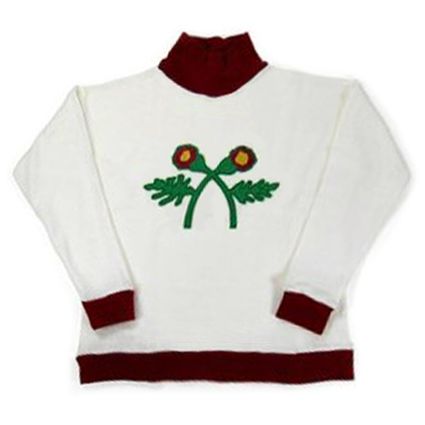 Today's video section, a look at the Kenora Thistles and hockey's early days. The original Thistles club disbanded in 1908, but subsequent clubs in Kenora have adopted the Thistles name, which was the case for the club that Louis McKay played on in 1934.
Today's video section, a look at the Kenora Thistles and hockey's early days. The original Thistles club disbanded in 1908, but subsequent clubs in Kenora have adopted the Thistles name, which was the case for the club that Louis McKay played on in 1934.
Griffis was noted for his speed and played both rover and cover-point (defense) during the seven-man era in the early days of organized hockey. He played 5 games during the 1902-03 season, scoring his first 5 goals as Rat Portage won the league title. They then challenged the Ottawa Hockey Club for the Stanley Cup in March of 1903. Ottawa defeated the Thistles 6-2 and 4-2 to retain the cup 2 games to none.
His offensive game flourished the next two season, as he scored a dozen goals in 12 games, as well as being credited with a pair of assists. For the 1904-05 season, the amateur MNWHA turned professional, and with the move came a new name to the Manitoba Professional Hockey Association. Griffis had the best offensive season of his career, scoring 15 goals in just 8 games as Rat Portage when 7-1 to win the league title, which subsequently gave them the opportunity to challenge Ottawa, now known as the Senators, for the Stanley Cup.
The MAHA league champions and Stanley Cup challenging
1904-05 Rat Portage Thistles
With Senators star Frank McGee out for Game 1, the visiting Thistles cruised to a dominant 9-3 win. McGee returned to the ice for Game 2, won by Ottawa 4-2 and after their 5-4 win in the deciding third game, Ottawa had repelled the Thistles challenge once again.
Over the summer, the Rat Portage was combined with two nearby towns and a new name chosen by combining the first two letters of Keewatin, Norman and Rat Portage for the new municipality of Kenora.
Griffis remained a member of the now Kenora Thistles and scored 9 goals in 9 games of the 1905-06 season. Kenora had finished first in the league with a 7-1 record, with the Winnipeg Hockey Club just behind at 6-1-1. However, Winnipeg's tie with the Brandon Hockey Club was replayed, which allowed Winnipeg to tie Kenora for the league title. This necessitated a playoff, which was won by Kenora, again giving them the right to challenge for the Stanley Cup. However, the challenge was not actually played until the following season!
The 1906 Kenora Thistles pose with their impressive
Manitoba league championship trophy
Manitoba league championship trophy
The 1906-07 season began and shortly after the calendar flipped to 1907, Kenora finally were able to get their shot at the Montreal Wanderers for the Stanley Cup. The format this time was a two-game, total-goals series to be played at the Montreal Arena on January 17th and 21st.
The Thistles loaded their roster with ringers and future Hall of Famers Tom Hooper, Tommy Phillips. "Bad" Joe Hall and Art Ross. Game 1 went to the Thistles 4-2, with Phillips scoring all four goals for Kenora. Game 2 saw both Phillips and Hooper score hat tricks as the Thistles won 8-6 to take the series 12-8 and become the smallest city to ever win the Stanley Cup. Griffis played cover-point during both games.
Kenora finished second in the four team MPHA and won their mid-March playoff against Brandon Wheat City to retain the rights to the Stanley Cup with wins of 8-6 and 4-1.
The 1907 Stanley Cup Champion Kenora Thistles luckily took the time
to pose with their trophy during the brief time they held it with
Griffis front row on the left
Griffis front row on the left
Five days later Kenora faced another challenge for the cup, this from the Wanderers, 1907 champions of the Eastern Canada Amateur Hockey Association. The series was played in Winnipeg and Game 1 saw the Wanderers dominate with a 7-2 win to open the two-game, total-goals series. Kenora fought hard and won Game 2 by a score of 6-5, which included a goal by Griffis, but Montreal's 5 goal advantage was too great to overcome, ending Kenora's reign as champions of Canada after two short months.
Griffis then took some extended time away from hockey, not playing for the next two seasons. He played for the Nelson Hockey Club in British Columbia for the 1909-10 season before not playing again in 1910-11.
All that changed when Frank Patrick and Lester Patrick formed the new Pacific Coast Hockey Association for the 1911-12 season and came calling in an effort to help fill the rosters of their three member clubs. Griffis became a member of Frank's Vancouver Millionaires, and in 15 games, contributed 8 goals.
Griffis, far left, and the inaugural Vancouver Millionaires
For the 1912-13 season, Griffis just missed out on being in the top ten in league scoring with 10 goals and 3 assists in 14 games. The next two seasons saw him score an identical 2 goals and 5 points. Vancouver, after four tries, finally won the PCHA championship and hosted the Stanley Cup Finals against the Senators, now of the National Hockey Association.
The 1913-14 Vancouver Millionaires
Vancouver took Game 1 6-2 under PCHA rules. Game 2, played under NHA rules, did not slow the Millionaires, who took a commanding 2-0 lead in their best-of-five series with a 8-3 romp. Ottawa could not respond in their must-win Game 3, and Vancouver became the first western team to win the Stanley Cup with an overpowering 12-3 to sweep the series in three straight with Griffis as their team captain, leading a roster which also included future Hall of Famers Cyclone Taylor, Mickey MacKay, Barney Stanley, Frank Nighbor, Frank Patrick and goaltender Hughie Lehman.
In 1915-16 Griffis raised his previous offensive numbers to 7 goals and 12 points followed by 7 goals and 11 points in 1916-17.
For the 1917-18 season, Griffis had 3 goals and 8 points in 8 games as Vancouver finished in second place. Unlike in the early days of hockey when the first place team would then challenge for the cup, the PCHA now had first place play the second finisher for the league championship. In a tight, closely fought series, the Seattle Metropolitains won the first game 2-1, but when the Millionaires took Game 2 by a 2-0 shutout, they won the series 3 goals to 2, which earned them a trip to Toronto to take on the Toronto Arenas of the first year National Hockey League.
Game 1 went to Toronto playing under the NHL's six man rules 5-3, but with the PCHA's seven man rulebook, Vancouver won 6-4 in Game 2. Toronto moved ahead with a 6-3 lead back under NHL rules, but Vancovuer stayed alive with an 8-1 thrashing of the home team back under the PCHA format. In a nailbiter, Toronto won the Stanley Cup thanks to a 2-1 win in the deciding Game 5.
Griffis had suffered a leg injury back in 1915, which did not heal well, and finally after just two games played in the 1918-19 season, he retired from top level hockey. He did continue to play senior hockey for a number of years and was a competitive bowler and golfer. In July of 1950, Griffis was inducted into the Hockey Hall of Fame before he passed away later that same month at the age of 66.
Today's featured jersey is a 1907 Kenora Thistles Si Griffis jersey. The Thistles name was chosen in a contest and the winner was a local Scottish carpenter named Bill Dunsmore, who not only submitted the name in reference to the region's Scottish heritage, but a drawing of a thistle for the team's logo.
This jersey is the style worn by the 1907 Stanley Cup champion Thistles club. These jerseys were reproduced by the CBC in connection with their "Hockey: A People's History" documentary, and are sadly no longer available on demand.

Tuesday, September 20, 2016
1977-78 Montreal Canadiens Guy Lafleur Jersey
After beginning he career with the Quebec Aces of the Quebec Junior Hockey League in the 1966-67 season with eight games, Guy Lafleur, born on this date in 1951, played two more seasons for the Aces, scoring 30 goals and 49 points in 43 games in 1967-68, but really turned heads in 1968-69 with 50 goals and 110 points in 49 games of the 1968-69 season, averaging more than a goal and more than an assist per game.
He then progressed up the ladder to the Quebec Remparts of the Quebec Major Junior Hockey League, where he blossomed with a league leading 103 goals and 170 points in 56 games in 1969-70. Then, in just 15 playoff games, Lafleur scored 43 points from 25 goals and 18 assists.
With Lafleur looking to be a can't miss NHL prospect available in the 1971 NHL Draft, the Montreal Canadiens General Manager Sam Pollock, looking to replace the aging Jean Beliveau, who would play just one more NHL season, fleeced the California Golden Seals by sending them Montreal's first choice in the 1970 draft and Ernie Hicke for not only the Golden Seals first pick in the 1971 draft, but a player, Francois Lacombe, as well.
Lafleur announced his readiness for the NHL with a stellar second season with the Remparts, when he again led the league with an astonishing 130 goals on his way to a 209 points to earn the Jean Beliveau Trophy as the QMJHL scoring champion. Lefleur then duplicated his playoff performance from 1970 when he scored an identical 43 points, only now in one game less than the previous year, 14. The Remparts then advance to the Memorial Cup playoffs, where the prolific Lafleur averaged 2 points per game with 9 goals and 5 assists in 7 games as Quebec won the Memorial Cup.
Hoping the Golden Seals would come through by finishing last, Pollock was alarmed when the Los Angeles Kings began playing quite poorly in 1970-71. In an effort to shore up the Kings, Pollock sent veteran Ralph Backstrom to Los Angeles. The addition of Backstrom ensured that the Kings would avoid the cellar and secured the first pick of Lafleur for Montreal.
With Lafleur safely now a part of the bleu, blanc et rouge, he produced 29 goals and 64 points as an NHL rookie in 73 games in 1971-72. His next two seasons were similar, with 28 goals and 55 points in 1972-73 and a drop in goals to 21 in 1973-74, but an increase in assists saw his point total increase to 56. During the 1973 playoffs, Lafleur contributed 3 goals and 8 points in 17 games as the Canadiens won the first Stanley Cup of his career.
As if someone flipped a switch, Lafleur took his game to another level for the 1974-75 season when he scored the first of his six consecutive 50 or more goal seasons when he scored 53 goals and 66 assists for 119 points to lead the Canadiens in scoring for the first time.
The 1975-76 season saw Lafleur lead not only the Canadiens, but all of the NHL with 56 goals and 69 assists for 125 points for his first Art Ross Trophy. During the Stanley Cup playoffs, Lafleur would score the cup winning goal for Montreal as they defeated the two-time champion Philadelphia Flyers, whose slug it until you win it style could not overcome the speed and skill of the Canadiens. Following the season, Lafleur was voted as the winner of the Pearson Award as the Most Valuable Player by his fellow players.
Before the 1976-77 season began, Lafleur made his international hockey debut as a part of Team Canada that would win the inaugural Canada Cup tournament over Czechoslovakia.
Lafleur would dominate the 1976-77 NHL season when he won his second consecutive Art Ross Trophy with a career high 136 points from 56 goals and 80 assists. He would finish the season a +89 and win not only the Pearson Award, but also his first Hart Trophy as NHL MVP as voted on my the NHL Hockey Writers Association. His 9 goals and 17 assists would lead all players in playoff scoring as the Canadiens would win the 1977 Stanley Cup over the rival Boston Bruins. His efforts would earn Lafleur the Conn Smythe Trophy as playoff MVP. In recognition of his outstanding NHL season, he was the recipient of both the Lionel Conacher Award as Canada's Top Male Athlete and the Lou Marsh Trophy as Canada's Top Athlete.
Still fully on top of his game, the fluid skating right winger continued to dominate the NHL in 1977-78. He set a career high by hitting the 60 goal plateau and added 72 assists for 132 points to claim his third consecutive Art Ross Trophy as the NHL's leading scorer. He would also win his second consecutive Hart Trophy and third straight Pearson Award as league MVP. The Canadiens, led by Lafleur's 21 points in 15 games, would defeat the Bruins again for their third straight Stanley Cup, the fourth of Lafleur's career.
Despite a 52 goal, 129 point season, Lafleur would finally have to relinquish his standing at the NHL's top scorer, finishing third behind Bryan Trottier (134) and Marcel Dionne (130). Al l was not lost, however, as the Canadiens would capture their fourth consecutive Stanley Cup and 5th for Lafleur, when they defeated the New York Rangers as Lafleur led the team in scoring with 23 playoff points.
During the 1978-79 season, Lafleur was also named as a member of the NHL All-Star team that took part in the 1979 Challenge Cup, a three game series against the Soviet Union that took the place of the traditional NHL All-Star Game that season.
Lafleur's sixth and final 50 goal season came in 1979-80 when he led the Canadiens for the sixth consecutive season with 125 points, which was again good for third in the league behind NHL newcomer Wayne Gretzky and Marcel Dionne, who tied with 137 points. His feat made him the first player to ever have six consecutive 50 goal, 100 point seasons in league history.
Age and injuries would begin to take their toll on Lafleur beginning with the 1980-81 season, as he was limited to 51 games, never having played less than 70 during his previous nine NHL seasons. He did score his 1,000th point on March 4, 1981, setting a then NHL record for the fastest player to 1,000 points, having done so in just 720 games.
In 1981-82 he saw action in 66 games followed by 68 in 1982-83. During each of those shortened campaigns, Lafleur scored an identical 27 goals, with 84 points in 1981-82 being his best. In 1982-83, Montreal was a shadow of it's former self, and Lafleur's 76 points were enough to lead the team in scoring for the seventh time.
During that time period, Lafleur competed in his only World Championships for Canada in 1981, scoring a goal in 7 games as well as taking part in his second Canada Cup later that fall as the Canadians finished as runner up to the Soviets despite Lafleur scoring 11 points in 7 games.
He played in all 80 of Montreal's games in 1983-84, scoring 30 goals and 70 points as the Canadiens team leader once more. Mind you, Gretzky led the league with 205 that season... After three consecutive first round postseason exits, the Canadiens did go on a nice run, making it to the third round of the playoffs, but Lafleur only contributed 3 assists in 12 of Montreal's 15 games.
His final season with Montreal saw him play just 19 games, scoring just 2 goals and 5 points, before he decided to retire. In front of 18,000 fans, he took one last skate around the ice and received a five minute standing ovation. "After 13 years, I couldn't accept to be number two. I'm proud of what I did in the past and I'm proud I played for the Canadiens, especially on five Stanley Cup winners. I was in a slump and I wasn't scoring much a the time. I was frustrated," Lafleur recalled about his decision to retire.
Lafleur became the sixth Canadien to have his number retired and was inducted into the Hockey Hall of Fame on 1988.
However... he still believed he could play after three seasons away from the game and signed to play with the New York Rangers for the 1988-89 season. He played in 67 games for New York before being sidelined by a knee injury, becoming only the second player after Gordie Howe to play after being inducted into the Hockey Hall of Fame. He totaled 18 goals and 45 points, including scoring twice during his first game back in the Montreal Forum against Patrick Roy as the fans chanted his name every time he touched the puck just as they had during the peak of his career as a Canadien.
Rangers head coach, and Lafleur's close friend Michel Bergeron was dismissed and joined the Quebec Nordiques, who also signed Lafleur for the 1989-90 season, who stood out on the ice, as he was allowed to play without a helmet, while all new players into the league were now required to wear one since the 1979-80 season. Lafleur reportedly turned down a more lucrative offer from the Los Angeles Kings, preferring to play in his native Quebec.
During his two seasons with the Nordiques, Lafleur played in 39 games his first season, scoring 12 goals and 34 points, followed by 59 games in 1990-91, again scoring 12 goals on his way to 28 points before he retired again, this time for good.
His final NHL totals were 560 goals and 793 assists for 1,353 points in 1,126 games with an additional 58 goals and 134 points in 128 playoff games. He won five Stanley Cups, 3 scoring titles, 2 Hart Trophies and 3 Pearson Awards as MVP, a Conn Smythe Trophy and a Canada Cup. Lafleur also played in the NHL All-Star Game in 1975, 1976, 1977, 1978, 1980 and 1991 as well as being on the Challenge Cup team in 1979. He is the Canadiens all-time scoring leader and holds the club single season scoring record with 136.
Today's featured jersey is a 1977-78 Montreal Canadiens Guy Lafleur jersey as worn during his career year when he set a personal best and Canadiens team record of 136 points on his way to winning the Art Ross Trophy, the Hart Trophy and the Pearson Award as well as the Stanley Cup.
Bonus jersey: Today's bonus jersey is a 1971-72 Montreal Canadiens Guy Lafleur jersey as worn during Lafleur's rookie season in the NHL.
The Canadiens red sweaters with the blue band around the chest date back to before the formation of the NHL in 1917 and this exact variation with the lace up collar and numbers inside the arms stripes dates back to 1966-67 and remained in use through 1974-75 when it was replaced by a new v-neck collar.
Extra bonus jersey: Today's extra bonus jersey is a 1990-91 Quebec Nordiques Guy Lafleur jersey as worn during his final season in the NHL, his second in Quebec.
Today's video section is the always excellent Legends of Hockey series profile of Lafleur.
He then progressed up the ladder to the Quebec Remparts of the Quebec Major Junior Hockey League, where he blossomed with a league leading 103 goals and 170 points in 56 games in 1969-70. Then, in just 15 playoff games, Lafleur scored 43 points from 25 goals and 18 assists.
With Lafleur looking to be a can't miss NHL prospect available in the 1971 NHL Draft, the Montreal Canadiens General Manager Sam Pollock, looking to replace the aging Jean Beliveau, who would play just one more NHL season, fleeced the California Golden Seals by sending them Montreal's first choice in the 1970 draft and Ernie Hicke for not only the Golden Seals first pick in the 1971 draft, but a player, Francois Lacombe, as well.
Lafleur announced his readiness for the NHL with a stellar second season with the Remparts, when he again led the league with an astonishing 130 goals on his way to a 209 points to earn the Jean Beliveau Trophy as the QMJHL scoring champion. Lefleur then duplicated his playoff performance from 1970 when he scored an identical 43 points, only now in one game less than the previous year, 14. The Remparts then advance to the Memorial Cup playoffs, where the prolific Lafleur averaged 2 points per game with 9 goals and 5 assists in 7 games as Quebec won the Memorial Cup.
Lafleur celebrates winning the 1971 Memorial Cup
Hoping the Golden Seals would come through by finishing last, Pollock was alarmed when the Los Angeles Kings began playing quite poorly in 1970-71. In an effort to shore up the Kings, Pollock sent veteran Ralph Backstrom to Los Angeles. The addition of Backstrom ensured that the Kings would avoid the cellar and secured the first pick of Lafleur for Montreal.
With Lafleur safely now a part of the bleu, blanc et rouge, he produced 29 goals and 64 points as an NHL rookie in 73 games in 1971-72. His next two seasons were similar, with 28 goals and 55 points in 1972-73 and a drop in goals to 21 in 1973-74, but an increase in assists saw his point total increase to 56. During the 1973 playoffs, Lafleur contributed 3 goals and 8 points in 17 games as the Canadiens won the first Stanley Cup of his career.
As if someone flipped a switch, Lafleur took his game to another level for the 1974-75 season when he scored the first of his six consecutive 50 or more goal seasons when he scored 53 goals and 66 assists for 119 points to lead the Canadiens in scoring for the first time.
The 1975-76 season saw Lafleur lead not only the Canadiens, but all of the NHL with 56 goals and 69 assists for 125 points for his first Art Ross Trophy. During the Stanley Cup playoffs, Lafleur would score the cup winning goal for Montreal as they defeated the two-time champion Philadelphia Flyers, whose slug it until you win it style could not overcome the speed and skill of the Canadiens. Following the season, Lafleur was voted as the winner of the Pearson Award as the Most Valuable Player by his fellow players.
Before the 1976-77 season began, Lafleur made his international hockey debut as a part of Team Canada that would win the inaugural Canada Cup tournament over Czechoslovakia.
Lafleur won the Canada Cup in 1976 against the Czechs
Lafleur would dominate the 1976-77 NHL season when he won his second consecutive Art Ross Trophy with a career high 136 points from 56 goals and 80 assists. He would finish the season a +89 and win not only the Pearson Award, but also his first Hart Trophy as NHL MVP as voted on my the NHL Hockey Writers Association. His 9 goals and 17 assists would lead all players in playoff scoring as the Canadiens would win the 1977 Stanley Cup over the rival Boston Bruins. His efforts would earn Lafleur the Conn Smythe Trophy as playoff MVP. In recognition of his outstanding NHL season, he was the recipient of both the Lionel Conacher Award as Canada's Top Male Athlete and the Lou Marsh Trophy as Canada's Top Athlete.
Still fully on top of his game, the fluid skating right winger continued to dominate the NHL in 1977-78. He set a career high by hitting the 60 goal plateau and added 72 assists for 132 points to claim his third consecutive Art Ross Trophy as the NHL's leading scorer. He would also win his second consecutive Hart Trophy and third straight Pearson Award as league MVP. The Canadiens, led by Lafleur's 21 points in 15 games, would defeat the Bruins again for their third straight Stanley Cup, the fourth of Lafleur's career.
Yvon Lambert, Yvan Cournoyer and Guy Lafleur
hoisting the Stanley Cup in 1978
During the 1978-79 season, Lafleur was also named as a member of the NHL All-Star team that took part in the 1979 Challenge Cup, a three game series against the Soviet Union that took the place of the traditional NHL All-Star Game that season.
Lafleur's sixth and final 50 goal season came in 1979-80 when he led the Canadiens for the sixth consecutive season with 125 points, which was again good for third in the league behind NHL newcomer Wayne Gretzky and Marcel Dionne, who tied with 137 points. His feat made him the first player to ever have six consecutive 50 goal, 100 point seasons in league history.
Age and injuries would begin to take their toll on Lafleur beginning with the 1980-81 season, as he was limited to 51 games, never having played less than 70 during his previous nine NHL seasons. He did score his 1,000th point on March 4, 1981, setting a then NHL record for the fastest player to 1,000 points, having done so in just 720 games.
Lafleur acknowledging the fans after scoring his 1000th point
In 1981-82 he saw action in 66 games followed by 68 in 1982-83. During each of those shortened campaigns, Lafleur scored an identical 27 goals, with 84 points in 1981-82 being his best. In 1982-83, Montreal was a shadow of it's former self, and Lafleur's 76 points were enough to lead the team in scoring for the seventh time.
During that time period, Lafleur competed in his only World Championships for Canada in 1981, scoring a goal in 7 games as well as taking part in his second Canada Cup later that fall as the Canadians finished as runner up to the Soviets despite Lafleur scoring 11 points in 7 games.
Wayne Gretzky and Guy Lafleur chatting during the 1981 Canada Cup
He played in all 80 of Montreal's games in 1983-84, scoring 30 goals and 70 points as the Canadiens team leader once more. Mind you, Gretzky led the league with 205 that season... After three consecutive first round postseason exits, the Canadiens did go on a nice run, making it to the third round of the playoffs, but Lafleur only contributed 3 assists in 12 of Montreal's 15 games.
His final season with Montreal saw him play just 19 games, scoring just 2 goals and 5 points, before he decided to retire. In front of 18,000 fans, he took one last skate around the ice and received a five minute standing ovation. "After 13 years, I couldn't accept to be number two. I'm proud of what I did in the past and I'm proud I played for the Canadiens, especially on five Stanley Cup winners. I was in a slump and I wasn't scoring much a the time. I was frustrated," Lafleur recalled about his decision to retire.
Lafleur became the sixth Canadien to have his number retired and was inducted into the Hockey Hall of Fame on 1988.
the Hockey Hall of Fame in 1988
However... he still believed he could play after three seasons away from the game and signed to play with the New York Rangers for the 1988-89 season. He played in 67 games for New York before being sidelined by a knee injury, becoming only the second player after Gordie Howe to play after being inducted into the Hockey Hall of Fame. He totaled 18 goals and 45 points, including scoring twice during his first game back in the Montreal Forum against Patrick Roy as the fans chanted his name every time he touched the puck just as they had during the peak of his career as a Canadien.
Lafleur waves to his fans in Montreal after being named
the game's #1 Star on his return to the forum with the Rangers
Rangers head coach, and Lafleur's close friend Michel Bergeron was dismissed and joined the Quebec Nordiques, who also signed Lafleur for the 1989-90 season, who stood out on the ice, as he was allowed to play without a helmet, while all new players into the league were now required to wear one since the 1979-80 season. Lafleur reportedly turned down a more lucrative offer from the Los Angeles Kings, preferring to play in his native Quebec.
During his two seasons with the Nordiques, Lafleur played in 39 games his first season, scoring 12 goals and 34 points, followed by 59 games in 1990-91, again scoring 12 goals on his way to 28 points before he retired again, this time for good.
His final NHL totals were 560 goals and 793 assists for 1,353 points in 1,126 games with an additional 58 goals and 134 points in 128 playoff games. He won five Stanley Cups, 3 scoring titles, 2 Hart Trophies and 3 Pearson Awards as MVP, a Conn Smythe Trophy and a Canada Cup. Lafleur also played in the NHL All-Star Game in 1975, 1976, 1977, 1978, 1980 and 1991 as well as being on the Challenge Cup team in 1979. He is the Canadiens all-time scoring leader and holds the club single season scoring record with 136.
Today's featured jersey is a 1977-78 Montreal Canadiens Guy Lafleur jersey as worn during his career year when he set a personal best and Canadiens team record of 136 points on his way to winning the Art Ross Trophy, the Hart Trophy and the Pearson Award as well as the Stanley Cup.
This
style jersey dates back to 1941 and, aside from a version with a blue
stripe around the chest for three years in the late 40's, has remained
essentially unchanged ever since.
Bonus jersey: Today's bonus jersey is a 1971-72 Montreal Canadiens Guy Lafleur jersey as worn during Lafleur's rookie season in the NHL.
The Canadiens red sweaters with the blue band around the chest date back to before the formation of the NHL in 1917 and this exact variation with the lace up collar and numbers inside the arms stripes dates back to 1966-67 and remained in use through 1974-75 when it was replaced by a new v-neck collar.
photo courtesy of Classic Auctions
Extra bonus jersey: Today's extra bonus jersey is a 1990-91 Quebec Nordiques Guy Lafleur jersey as worn during his final season in the NHL, his second in Quebec.
Today's video section is the always excellent Legends of Hockey series profile of Lafleur.
Labels:
Lafleur Guy,
Montreal Canadiens,
Quebec Nordiques
Subscribe to:
Comments (Atom)

